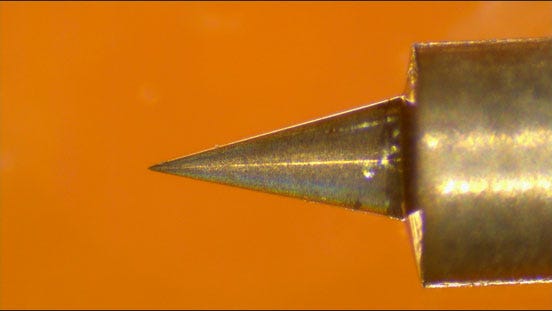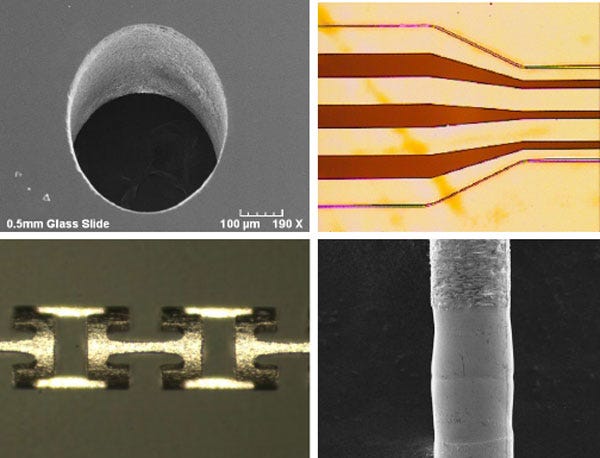March 1, 2016
Laser micro machining is playing an important role in fostering the development of novel wearable sensors.
Glenn Ogura
|
Figure 1: This stainless steel part demonstrates the precision offered by micro-needle fabrication. |
Biosensor technology is fueling an explosion in the amount of health-related data that is directly collected from the human body. These tiny, intricate devices can sit on top of the skin or deep within tissue or vasculature. The industry demands millions of sensors each year. As the biosensor industry has evolved, laser micro manufacturing has emerged as a technology that enables biosensors to be made cost-effectively with consistency and high quality.
The first "biosensor" was applied to the skin of diabetes patients where it continuously or intermittently measured their blood glucose levels, helping them avoid multiple finger-pricks to test their blood. The long-term goal was for it to work in conjunction with insulin pumps to create the so-called "artificial pancreas," which would close the control loop and make it easier for diabetic patients to achieve good blood sugar numbers.
Today, the proliferation of novel wearable devices can be seen at any major electronics' conference. This is proof that biosensors detect many more metrics than just the heart rate after a workout. For example, molecular biosensors detect the change in antibodies, nucleic acids, enzymes, and ion channels. Biosensors can use a modified protein or enzyme to detect a specific analyte to aid in drug discovery for pharmaceutical and biotechnology companies.
|
Figure 2: Ablation of 25 micron thick polyimide coating from copper pad. |
New biosensors are generally made with a hybrid of many material types such as glass, polymers, and metals. This is different than conventional semiconductor chips, which use a standardized material set (some of which are not biocompatible). The combination of materials leads to manufacturing challenges that laser micro manufacturing can solve. With the advent of short pulse and short wavelength lasers, the entire material set of biosensors can be ablated, cut, drilled, and welded down to the micron level. For example, electro-chemical biosensors have sensing and reference electrodes that need to be selectively exposed, necessitating a particular set of polymers and thin metals. Optical sensors use the properties of lasers to interrogate biomolecules to elicit a reaction.
So how else can laser micro manufacturing support biosensor fabrication? You'd be hard-pressed to fabricate the applications below without laser technology:
Micro-needle fabrication that cannot be cost-effectively done by conventional mechanical methods.
Ablate polymer coatings or resists (even those whose thickness is poorly controlled) to expose the underlying metal electrodes more consistently and precisely than with masking techniques.
Drill via holes and portal holes into glass and polymer microfluidic chips, especially as chips become thinner or the analyte volumes decrease.
Singulate hybrid sensors into individual devices without debris or thermal damage.
Selectively cut ultra-thin metal electrodes for electrical isolation purposes after mass fabrication of the entire device.
Micro-welding of metal electrodes or thin wires.
Laser micro manufacturing is an essential fabrication tool for the biosensor designer. Not only the ability to perform a single step process, unlike multi-step lithography significantly reduces the prototyping time, but also the laser process can be scaled up for volume manufacturing of millions of devices per year.
|
Figures 3 in the upper left-hand corner shows glass via hole drilling. Figure 4 on the right shows laser singulation of a hybrid sensor. Figure 5 on the lower left shows laser micro cutting of metals (such as electrodes) while figure 6 in the lower right-hand corner shows micro-welding of 75-micron diameter nitinol wires. |
Glenn Ogura is the SVP market development at Resonetics.
Visit Resonetics booth (#221) at BIOMEDevice Boston, April 13-14, 2016. |
About the Author(s)
You May Also Like





